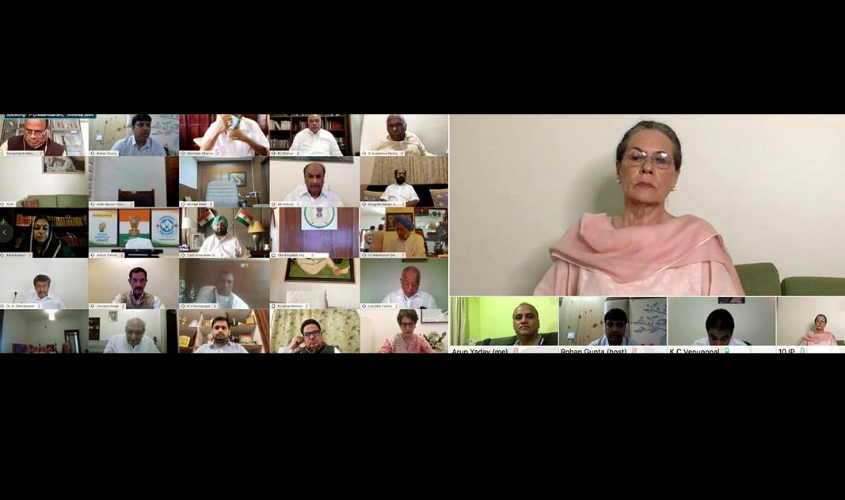Palace revolt doesn’t scrape the Nehru-Gandhis.
The strategy to isolate the G-23 mutineers had been put in place a well before their letter was “leaked” on 23 August on the eve of the virtual meet of the extended Congress Working Committee. (The CWC expedient turned out to be a Circus within a Circus.) The five-member panel tasked to “discuss and formulate stand on key ordinances” (which will be introduced as legislation in the Monsoon Session of Parliament), formally announced two days after the CWC meet, had been formalised a week before, keeping out all the 23 worthies. The inclusion of P. Chidambaram, Digvijaya Singh, Jairam Ramesh, Gaurav Gogoi and Dr Amar Singh was a well thought out exercise. In subsequent days, Jairam Ramesh, the convener of the panel, was anointed chief whip in Rajya Sabha and young Gogoi became Lok Sabha deputy leader. The inclusion of former bureaucrat, Dr Amar Singh, the MP from Fatehgarh Sahib, in one go sent out a message to dissenters Manish Tewari, Mukul Wasnik and Veerappa Moily. A Dalit face of the party, he had as an officer played a role in formulation of MNREGA and as a former Food Corporation of India chairman is endowed to contribute to the discussion on the ordinances concerning farm sector, which have drawn some flak in Punjab and Haryana.
If the prime purpose of the G-23 was to stop Rahul Gandhi from re-emerging as the party chief then they have certainly gained credence. For the next six months Sonia Gandhi’s continuance as Congress President, albeit interim, has been settled. But the actions of the party after the CWC battle fatigue betray a clear stamp of Rahul Gandhi’s ascendancy. Maledictions of Ambika Soni in the meeting and the actions of party functionaries across the country suggest that a slugfest has been unleashed against the dissenters. Soni, who as president of Indian Youth Congress in 1976 had appointed Ghulam Nabi Azad as the Jammu & Kashmir Youth Congress chief, is said to have unleashed a no holds barred attack imprecating him. A. Chellakumar went a step further, wondering why Azad had been excluded from the list of former J&K Chief Ministers detained in the aftermath of Article 370 withdrawal: perhaps insinuating that the BJP was being kind to him.
After the meeting, a Congress minister in Maharashtra, Sunil Kedar tweeted that party workers will not allow Prithviraj Chavan, Milind Deora and Mukul Wasnik to move around in his state. Jitin Prasada’s home unit, the Lakhimpur Kheri district committee, asked for his expulsion (Dhiraj Gujjar, the DCC chief, later told media that he had received instructions from New Delhi). Command performances like these were noticed in 1969 and 1978 splits—this time though the dissenters are not seeking a breach. They are trying to act as Her Majesty’s loyal opposition. No ideological issues have been framed. Grievances are against the party’s functioning. Apart from Bhupinder Singh Hooda, who has a strong base in Haryana and late Arjun Singh’s son, Ajay (Rahul) Singh of Madhya Pradesh, none of the other 21 signatories can claim mass following. Some are Rajya Sabha members who are incapable of winning even a municipal ward in their home turf. In 1969 and 1978, and later in the V.P. Singh upheaval of 1988, heavyweights had challenged the leadership. The Congress (Tiwari) revolt against P.V. Narasimha Rao had a formidable leadership. No doubt that sulk swelled to a growl and then dissipated in a whimper in 2020.
The attack on Ghulam Nabi Azad was perhaps untoward. He began his journey as a Block Congress president in Jammu’s Bhalessa tehsil in 1973. Became state youth chief in 1976, Indian Youth Congress president in 1980 and has held key positions in the party and in government over past four decades. When Congress was out of power in 1977, he along with the late K.V. Panikker set up the Youth Congress office and kept the flag flying in extreme adversity. Indira Gandhi rewarded him by giving him Lok Sabha ticket from Washim in Maharashtra, as winning from J&K was not feasible for him then. His wedding to famous Kashmiri singer Shameem became a festive occasion for the party—Sanjay Gandhi led the “baraat” in Srinagar. In his interviews he has emphasised that his main demand is that the party must have an elected president, even if it be Rahul Gandhi. He has lamented that party polls were last held 23 years back (Did the number of signatories, 23, emanate from this?).
Political theorist Rajni Kothari in the 1960s defined Congress as a “party of consensus”, which functions through an elaborate labyrinth of factions. Post 1969 and 1978 splits this definition survived. In the heyday of Indira Gandhi in the 1970s, Congress Forum for Socialist Action was counterbalanced by a right-wing “Nehru Forum”. Ideological dialectic evaporated in the Rajiv Gandhi era and became a bygone by the time Sonia Gandhi emerged in 1998.
G-23 mutiny did not leave a bounty of any battle of ideas—it has been a growl of grievances. The Nehru-Gandhi dispensation has not been scraped by it. Congress continues to flounder. The party does not have the strength to even move a no-confidence motion in Parliament as it falls short of requisite numbers—ten per cent of membership in Lok Sabha.

